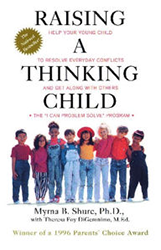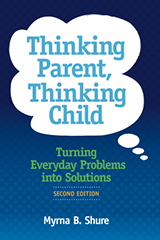Raising a Thinking Child
Help Your Young Child to Resolve Everyday Conflicts and Get Along with Others
The "I Can Problem Solve" Program
 by Myrna B. Shure, Ph.D. with Theresa Foy Digeronimo, M.ED
by Myrna B. Shure, Ph.D. with Theresa Foy Digeronimo, M.ED
Excerpt
Back to main Raising a Thinking Child page
Sample ICPS Dialogues
This chapter is not a cookbook of precisely measured recipes for raising thinking children. I don't expect that you'll read and memorize every dialogue and I certainly don't want you to think that they represent the only way to use ICPS with your children in the given situations. ICPS dialoguing is a style of talk with children but it is not based on a memorized script.
The dialogues will be most useful to you if you use them as a handy reference guide. Let's say, for example, that you find yourself slipping back into old habits -- you find that you can't stand the bickering and arguing that goes on among your children, and you revert to yelling. Rather than read through the whole book to get back on the ICPS track, a quick look through this chapter will remind you how you can talk about the problem the ICPS way. To make it even easier for you, if your child has a persistent problem that you seem to be losing ground on -- let's say grabbing toys away from other children -- you can look up Grabbing in this chapter (by checking the list on page 191) and refresh your memory about the questions you want to ask your child in this circumstance. The next time he grabs a toy, you'll be ready to ICPS immediately.
So this chapter can be used with a bookmark. If you need a quick refresher or have a specific problem you want to ICPS, here's where you can quickly brush up on the skill of raising an ICPS thinker.
Child-Child Problems
Child-child problems are ones that occur between children and their friends. As your children are learning and practicing ICPS, your role is to listen for when these kinds of problems occur and then to ask questions that prompt ICPS thinking.
Before we ICPS a typical problem among young children -- hitting -- let's take a look at some of the many responses I've heard parents use over the years. As you read through these non-ICPS conversations, see if any sound familiar to you. They point out several ways parents often deal with this problem.
Non-ICPS Conversations About Hitting
CHILD: Bobby hit me.
PARENT: When did he hit you?
CHILD: In school.
PARENT: I'll talk to the teacher about it tomorrow.
(In this conversation, the parent solves the problem. The child is not engaged in thinking about the problem at all.)
In the two conversations below, two mothers give their children different advice about the hitting problem, but they both use the same approach.
CHILD: Amy hit me today.
PARENT: Hit her back.
CHILD: She'd punch me in the nose.
PARENT: Every time she hits you, hit her back. I don't want you to be so timid.
CHILD: But I'm afraid.
PARENT: If you don't learn to defend yourself, kids will keep on hitting you.
CHILD: Okay.
CHILD: Danny knocked me down.
PARENT: What did you do then?
CHILD: I hit him back.
PARENT: You shouldn't hit back. Hitting is not nice. You might hurt someone. It's better to tell the teacher.
CHILD: Then he'll call me a tattletale.
PARENT: If you don't tell the teacher, he'll keep on hitting you.
CHILD: Okay.
(These parents ignored their children's view's and suggested consequences of their
own. One parent told her child what to do; the other, what not to do. But neither child was encouraged to think and decide for him- or herself)
When you tell your children how to solve the problem, whether or not your advice is accompanied by explanations, you miss the opportunity to encourage them to offer options of their own. If you insist that one solution is best, as in the above examples, the children are actively discouraged from thinking further about what to do and are left only with worry about how to do what you suggest. With the best of intentions, these parents ignored their children's perception of the problem and never found out why they were hit in the first place.
Sometimes parents do find out why a child was hit, but still are only concerned with what they think the child ought to do. For example:
PARENT: Why did he hit you?
CHILD: I don't know.
PARENT: Did you hit him first, take his toys, or what?
CHILD: I took his book.
PARENT: Are you supposed to take someone else's things?
CHILD: No.
PARENT: What are you supposed to do when you want something?
CHILD: Ask for it.
PARENT: Yes, you should ask. Taking his book is the wrong thing to do. That's why he hit you.
(Still this parent continues to impose her own solution rather than extract one from the child's view.)
Some parents include in their conversation thoughts about other people's feelings. But merely telling
children how people feel does not stimulate them to think further about it
PARENT: Why did Trisha hit you?
CHILD: Her friend told her to.
PARENT: That must have made you angry.
CHILD: Yeah. I'm gonna throw sand in her face.
PARENT: If you do that, she'll get angry, and then you'll have a real fight on your hands. Show her you're a big girl and pay her no mind.
(This parent talks about feelings but is most intent on teaching her child not to hit.)
In all these instances, the advice may differ but the approach is the same: The parent does the thinking for the child. ICPS is different; the ICPS parent guides the child to think about the problem.
An ICPS Dialogue About Hitting
Take a look at this full ICPS dialogue about hitting. To remind you of the purpose of some of the questions, I've pointed out the ICPS process as it appears.
PARENT: Terry, who hit you?
CHILD: Natalie.
PARENT: What happened? Why did she hit you?
(Parent looks for child's view of the problem.)
CHILD: She just hit me.
PARENT: You mean she just hit you for no reason?
(Parent encourages child to think of causes.)
CHILD:Well, I hit her first.
PARENT: What for?
CHILD: She won't let me look at her book.
PARENT: How did Natalie feel when you hit her?
(Parent guides child to think of feelings of others.)
CHILD: Mad.
PARENT: Do you know WHY she doesn't want you to look at her book?
(Parent guides child to appreciate point of view of others.)
CHILD: No.
PARENT: How can you find out?
CHILD: I could ask her.
PARENT: See if you can find out.
(Parent encourages child to seek facts and discover the problem.)
(later)
CHILD: She said I never let her see my books.
PARENT: Now that you know why she said no, can you think of something you could do or say so she'll let you look at her book?
(Parent encourages child to think of solution.)
CHILD: I could stop playing with her.
PARENT: What MIGHT happen if you do that?
(Child is guided to think of consequences of her solution.)
CHILD: She might not be my friend.
PARENT: Do you want her to be your friend?
CHILD: Yes.
PARENT: Can you think of something DIFFERENT to do so she'll still be your friend?
(Parent encourages further solution thinking.)
CHILD: I could let her have one of my books.
PARENT: That's a DIFFERENT idea. Why don't you try that?
When this mother discovered that her child hit first, she didn't offer advice or lecture on the pros and cons of hitting. Instead she continued the ICPS dialogue by encouraging her child to think about Natalie's feelings and the original problem (wanting the book). Then she helped her child look for alternative ways to solve the problem and consider what might happen as a result of those solutions. In the end, it's the child who will solve this problem, not the parent -- that's ICPS.
In the ICPS child-child and parent-child dialogues throughout this chapter, you'll find one way in which parents have used the problem-solving approach when a particular problem came up. Once you have a feel for this approach, you will find the process easy to adapt to whichever problem or conflict arises.


